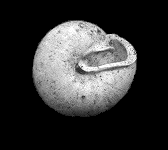Reproduction
 Euchemotrema fraternum (left), like most
terrestrial gastropods, is a functional
hermaphrodite;
it has both female and male sex
organs. These organs include: testes, sperm,
penis, ovaries, eggs, oviduct and a pouch/receptacle for
holding sperm of the mating partner.
Self-fertilization is very rare among all
terrestrial snails, as well as the Upland Pillsnail
(Dourson 2006). Terrestrial
snails have well-developed courtship rituals
(Willmer 2005).
Euchemotrema fraternum (left), like most
terrestrial gastropods, is a functional
hermaphrodite;
it has both female and male sex
organs. These organs include: testes, sperm,
penis, ovaries, eggs, oviduct and a pouch/receptacle for
holding sperm of the mating partner.
Self-fertilization is very rare among all
terrestrial snails, as well as the Upland Pillsnail
(Dourson 2006). Terrestrial
snails have well-developed courtship rituals
(Willmer 2005).
The Upland Pillsnail lays eggs in logs, moist leaf material, soil, or decaying vegetation (Dourson 2006; Gugler 1963). The eggs of the Upland Pillsnail are flexible, not brittle, and whitish in color. Some snails in the family Polygyridae have been known to dig burrows 1 to 2 cm deep and deposit five to ten eggs with a gelatinous outer layer (Gugler 1963). In the article, "Observations of Egg Laying Habits, Eggs, and Young of Land Mollusks on the Edmund Niles Huyck Preserve, Rensselaerville, New York," a study of the life history stages of the Upland Pillsnail was presented. The snails laid eggs from May to June in forest material by holding themselves in a particular spot using their muscular foot. Similarly, the size of the depression (egg-depositing site) was about 2 cm long and approximately 1 cm deep. It took about two minutes for each 2 mm egg to be deposited. About one month later, whorls on the immature shell were visible, along with a small visceral mass. Incubation period was an average of one month. The characteristics relating to color and anatomy were found to be quite different from the typical mature Upland Pillsnail (Ingram 1944). Though the egg-laying process is common in Euchemotrema fraternum, some species in the same Order as the Upland Pillsnail are actually "oviparous" and retain their eggs in their oviduct if climactic or other conditions are unfavorable (Willmer 2005).
Learn more about the anatomical
characteristics of the Upland Pillsnail on the
pages:
Adaptations
and Physical
Description.